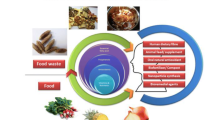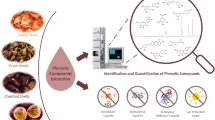Abstract
Purpose
Processing and selection of fruits and vegetables generate high amounts of wastes that represent an economical and environmental issue for the agroindustry sector. Nevertheless, according to so called “biorefinery” approach, this waste biomass can be exploited for the recovery of value added molecules. In this paper the residues of industrial processing of fennels, carrots, lemons and tomatoes were used as sources of polyphenols.
Methods
In order to optimize the recovery of polyphenols, different extraction techniques (maceration, ultrasound and microwave assisted extraction) were used in combination with different extraction media (water, ethanol, methanol and their mixtures). The polyphenols’ fractions were tested for their chemical and biological properties.
Results
All the obtained phenol fractions showed high antioxidant power and scavenging ability towards stable radical species and hydrogen peroxide. Moreover, the isolated polyphenol mixtures (containing remarkable compounds like quercetin, kaempferol, naringin, hesperetin) also displayed potential activities as anti-cancer, anti-microbial and acetylcholinesterase inhibiting agents.
Conclusions
Overall the obtained results showed that the residual matter produced by the industrial processing of fruits and vegetables contain high amounts of polyphenols. These polyphenolic fractions still retain their biological and antioxidant properties and therefore could be further exploited for other industrial applications.



Similar content being viewed by others
References
Sanchez-Vazquez, S.A., Hailes, H.C., Evans, J.R.G.: Hydrophobic polymers from food waste: resources and synthesis. Polym. Rev. 53(4), 627–694 (2013)
Di Donato, P., Fiorentino, G., Anzelmo, G., Tommonaro, G., Nicolaus, B., Poli, A.: Re-use of vegetable wastes as cheap substrates for extremophile biomass production. Waste Biomass Valoriz 2(2), 103–111 (2011)
Lama, L., Tramice, A., Finore, I., Anzelmo, G., Calandrelli, V., Pagnotta, E., Tommonaro, G., Poli, A., Di Donato, P., Nicolaus, B., Fagnano, M., Mori, M., Impagliazzo, A., Trincone, A.: Degradative actions of microbial xylanolytic activities on hemicelluloses from rhizome of Arundo donax. AMB Express 4, 55 (2014)
Finore, I., Poli, A., Di Donato, P., Lama, L., Trincone, A., Fagnano, M., Mori, M., Nicolaus, B., Tramice, A.: The hemicellulose extract from Cynara cardunculus: a source of value-added biomolecules produced by xylanolytic thermozymes. Green Chem. 18, 2460–2472 (2016)
Mouratoglou, E., Malliou, V., Makris, D.P.: Novel glycerol-based natural eutectic mixtures and their efficiency in the ultrasound-assisted extraction of antioxidant polyphenols from Agri-food waste biomass. Waste Biomass Valor (2016). doi:10.1007/s12649-016-9539-8
Pathak, P.D., Mandavgane, S.A., Kulkarni, B.D.: Valorization of pomegranate peels: a biorefinery approach. Waste Biomass Valor (2016). doi:10.1007/s12649-016-9668-0
Blidi, S., Bikaki, M., Grigorakis, S. et al.: A comparative evaluation of bio-solvents for the efficient extraction of polyphenolic phytochemicals: apple waste peels as a case study. Waste Biomass Valor (2015). doi:10.1007/s12649-015-9410-3
Manach, C., Mazur, A., Scalbert, A.: Polyphenols and prevention of cardiovascular diseases. Curr. Opin. Lipidol. 16, 77–84 (2005)
Pandey, K.B., Rizvi, S.I.: Plant polyphenols as dietary antioxidants in human health and disease. Oxid Med Cell Longev. 2(5), 270–278 (2009)
Vainio, H., Weiderpass, E.: Fruit and vegetables in cancer prevention. Nutr. Cancer. 54, 111–142 (2006)
Gómez-Estaca, J., López-de-Dicastillo, C., Hernández-Muñoz, P., Catalá R., Gavara R.: Advances in antioxidant active food packaging. Trends Food Sci. Technol. 35, 42–51 (2014)
Singleton, V.L., Rossi, J.A.: Colorimetry of total phenolics with phosphomolybdic phosphotungstic acid reagents. Am. J. Enol. Vitic 16, 144–158 (1965)
Prieto, P., Pineda, M., Aguilar, M.: Spectrophotometric quantitation of antioxidant capacity through the formation of a phosphomolybdenum complex: specific application to the determination of vitamin E. Anal. Biochem. 269(2), 337–341 (1999)
Benzie, I.F.F., Strain, J.J.: The ferric reducing ability of plasma (FRAP) as a measure of “Antioxidant power” The FRAP assay. Anal. Biochem. 239, 70–76 (1996)
Ough, C.S., Amerine M.A.: Methods for analysis of musts and wines (2nd Ed.) John Wiley and Sons, New York (1988)
Re, R., Pellegrini, N., Proteggente, A., Pannala, A., Yang, M., Rice-Evans, C.: Antioxidant activity applying an improved ABTS radical cation decolourisation assay. Free Radic. Biol. Med. 26, 1231–1237 (1999)
Ruch, R. J., Cheng, S.J., Klaunig, J.E.: Prevention of cytotoxicity and inhibition of intracellular communication by antioxidant catechins isolated from Chinese green tea. Carcinogenesis 10, 1003–1008 (1989)
Marston, A., Kissling, J., Hostettmann, K.: A rapid TLC bioautographic method for the detection of acetylcholinesterase and butyrylcholinesterase inhibitors in plants. Phytochem. Anal. 13, 51–54 (2002)
McClean, K.H., Winson, M.K., Fish, L., Taylor, A., Chhabra, S.R., Camara, M.: Quorum sensing and Chromobacterium violaceum: exploitation of violacein production and inhibition for the detection of N-acylhomoserine lactones. Microbiology 143, 3703–3711, (1997)
Fresco, P., Borges, F., Diniz, C., Marques, M.P.: New insights on the anticancer properties of dietary polyphenols. Med. Res. Rev. 26, 747–766 (2006)
Vizzotto, M., Porter, W., Byrne, D., Cisneros-Zevallos, L.: Polyphenols of selected peach and plum genotypes reduce cell viability and inhibit proliferation of breast cancer cells while not affecting normal cells. Food. Chem. 164, 363–370 (2014)
Daskiewicz, J.B., Depeint, F., Viornery, L., Bayet, Ch., Comte-Sarrazin, G., Comte, G., Gee, J.M., Johnson, I.T., Ndjoko, K., Hostettmann, K., Barrow, D.: Effects of flavonoids on cell proliferation and caspase activation in a human colonic cell line HT29: An SAR study. J. Med. Chem. 48, 2790–2804 (2005)
Nichenametla, S.N., Taruscio, T.G., Barney, D.L., Exon, J.H.: A review of the effects and mechanisms of polyphenolics in cancer. Crit. Rev. Food Sci. Nutr. 46, 161–183 (2006)
Schmidt, A.J., Krieg, J.C., Hemmeter, U.M., Kircher, T., Schulz, E., Clement, H.W., Heiser, P.: Impact of plant extracts tested in attention-deficit/hyperactivity disorder treatment on cell survival and energy metabolism in human neuroblastoma SH-SY5Y cells. Phytother. Res. 24(10), 1549–1553 (2006)
Gulati, N., Laudet, B., Michael, V., Zohrabian, M., Murali, R., Jhanwar-Uniyal, M.: The antiproliferative effect of quercetin in cancer cells is mediated via inhibition of the PI3K-Akt/PKB pathway. Anticancer Res. 26, 1177–1182 (2006)
Roduit, R., Schorderet, D.F.: MAP kinase pathways in UV-induced apoptosis of retinal pigment epithelium ARPE19 cells. Apoptosis. 13(3), 343–353 (2008)
Silvan, J.M., Requero, M., de Pascual-Teresa, S.: A protective effect of anthocyanins and xanthophylls on UVB-induced damage in retinal pigment epithelial cells. Food Funct. 17(2), 1067–1076 (2016)
Chusri, S., Villanueva, I., Voravuthikunchai, S.P., Davies, J.: Enhancing antibiotic activity: a strategy to control Acinetobacter infections. J. Antimicrob. Chemother. 64,1203–1211 (2009)
Fattouch, S., Caboni, P., Coroneo, V., Tuberoso, C.I.G., Angioini, A., Dessi, S., Marzouki, N., Cabras, P.: Antimicrobial activity of Tunisian quince (Cydonia oblonga Miller) pulp and peel pholiphenolic extracts. J. Agric. Food Chem. 55(3), 963–969 (2007)
Silvan, J.M., Mingo, E., Hidalgo, M., de Pascual-Teresa, S., Carrascosa, A.V., Martinez-Rodriguez, A.J.: Antibacterial activity of grape seed extract against Campylobacter spp. Food Control 29, 25–31 (2013)
Alvarez-Suarez, J.M., Tulipani, S., Diaz, D., Estevez, Y., Romandini, S., Giampieri, F., Damiani, E., Astolfi, P., Bompadre, S., Battino, M.M.A.B: Antioxidant and antimicrobial capacity of several monofloral Cuban honeys and their correlation with colour, polyphenol content and other chemical compounds. Food Chem. Toxicol. 48, 2490–2499 (2010)
Troiano, T., Harmanus, C., Sanders, I.M.J.G., Pasquale, V., Dumontet, S., Capuano, F., Romano, V., Kuijper, E.J.: Toxigenic Clostridium difficile PCR ribotypes in edible marine bivalve molluscs in Italy. Int. J. Food Microbiol. 208, 30–34 (2015)
Pasquale, V., Romano, V.J., Rupnik, M., Dumontet, S., Cižnar, I., Aliberti, F., Mauri, F., Saggiomo, V., Krovacek, K.: Isolation and characterization of Clostridium difficile from shellfish and marine environments. Folia Microbiol. 56, 431–437 (2011)
Pejin, B., Iodice, C., Tommonaro, G., De Rosa, S.: Synthesis and biological activities of thio-avarol derivatives. J. Nat. Prod. 71(11), 1850–1853 (2008)
Scott, L. J., Goa, K. L.: Galantamine: a review of its use in Alzheimer’s disease. Drugs. 60, 1095–1122 (2000)
Uriarte-Pueyo, I., Calvo, M.: Flavonoids as acetylcholinesterase inhibithors. Curr. Med. Chem. 18(34), 5289–5302 (2011)
Nazzaro, F., Fratianni, F., Coppola, R.: Quorum sensing and phytochemicals. Int. J. Mol. Sci. 14(6), 12607–12619 (2013)
Truchado, P., Giménez-Bastida, J.A., Larrosa, M., Castro-Ibáñez, I., Espín, J.C., Tomás-Barberán, F.A., García-Conesa, M.T., Allende, A.: Inhibition of quorum sensing (QS) in Yersinia enterocolitica by an orange extract rich in glycosylated flavanones. J. Agric. Food Chem. 60, 8885–8894 (2012)
Acknowledgements
This work was partially supported by the project PON03PE_00107 BioPoliS (Development of green technologies for production of BIOchemicals and their use in preparation and industrial application of POLImeric materials from agricultural biomasses cultivated in a sustainable way in Campania region) funded by MIUR (Italian Ministry of University and Research). The authors wish also to thank the Spanish Ministry of Economy and Competitiveness for financial support (AGL2012-30803).
Author information
Authors and Affiliations
Corresponding author
Ethics declarations
Conflict of interest
The authors declare that they have no actual or potential conflict of interest.
Rights and permissions
About this article
Cite this article
Di Donato, P., Taurisano, V., Tommonaro, G. et al. Biological Properties of Polyphenols Extracts from Agro Industry’s Wastes. Waste Biomass Valor 9, 1567–1578 (2018). https://doi.org/10.1007/s12649-017-9939-4
Received:
Accepted:
Published:
Issue Date:
DOI: https://doi.org/10.1007/s12649-017-9939-4




